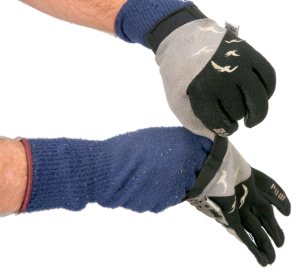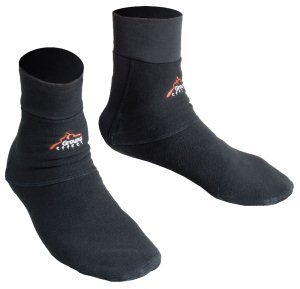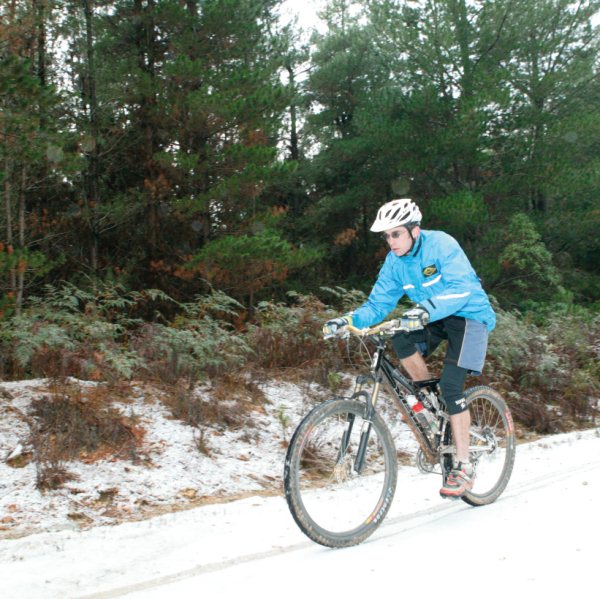Gear Up for Winter
Winter is coming but it doesn’t have to signal the end of your riding. The right gear, a little planning and the right mental approach will see you bounce through winter, emerging fitter and stronger at the other side.
Gauge Your Needs
 We don't live in the Antarctic, so it's never going to be that cold that you can't head out for a pedal. The key is adequate clothing for the conditions—too little and you'll obviously freeze, but overdressing can leave you equally uncomfortable. Stick a thermometer on the outside of your bedroom window and get familiar with what you need to wear in certain temperature ranges. That way, you'll only need to crawl out of bed, look at your thermometer and dress according to the conditions. You won't be faffing around trying to figure out what to wear, so you'll be more likely to get out the front door.
We don't live in the Antarctic, so it's never going to be that cold that you can't head out for a pedal. The key is adequate clothing for the conditions—too little and you'll obviously freeze, but overdressing can leave you equally uncomfortable. Stick a thermometer on the outside of your bedroom window and get familiar with what you need to wear in certain temperature ranges. That way, you'll only need to crawl out of bed, look at your thermometer and dress according to the conditions. You won't be faffing around trying to figure out what to wear, so you'll be more likely to get out the front door.
Toasty Fingers
 Keep your fingers warm and you will feel far more comfortable. However, most winter cycling gloves are designed for roadies and they don't seem to offer the 'bike feel' and robust build required for MTB use. There are one or two MTB specific winter gloves, but you can also use a thin polypropylene liner under your normal full fingered gloves. They are sold through outdoors/ski stores and add warmth without much bulk. Liners are also handy because they can be removed if the temperature rises later in your ride.
Keep your fingers warm and you will feel far more comfortable. However, most winter cycling gloves are designed for roadies and they don't seem to offer the 'bike feel' and robust build required for MTB use. There are one or two MTB specific winter gloves, but you can also use a thin polypropylene liner under your normal full fingered gloves. They are sold through outdoors/ski stores and add warmth without much bulk. Liners are also handy because they can be removed if the temperature rises later in your ride.
Cosy Toes
 As with your fingers, cold toes can make you feel uncomfortably chilled all over—it's funny how much our bodies value these 'extremities'. Once again you'll find plenty of 'booties' designed for road use, but you wouldn't want to wrap them around your MTB shoes and walk in them—they wouldn't last long. Thermal or windproof socks are the solution for colder conditions. You can even find wind and water resistant boot liners that will keep you reasonably cosy in truly horrible and wet conditions. If you live in a truly cold part of the country, you could even purchase some winter MTB shoes; don't expect to see them on the shelf in your local store but they do exist (the Europeans love them for cyclocross). Alternately, buy some shoes that are a fraction too big and wear thick thermal socks—obviously overkill in most of Australia, but it could be just the ticket for winter rides in the Victorian high country or Tassie.
As with your fingers, cold toes can make you feel uncomfortably chilled all over—it's funny how much our bodies value these 'extremities'. Once again you'll find plenty of 'booties' designed for road use, but you wouldn't want to wrap them around your MTB shoes and walk in them—they wouldn't last long. Thermal or windproof socks are the solution for colder conditions. You can even find wind and water resistant boot liners that will keep you reasonably cosy in truly horrible and wet conditions. If you live in a truly cold part of the country, you could even purchase some winter MTB shoes; don't expect to see them on the shelf in your local store but they do exist (the Europeans love them for cyclocross). Alternately, buy some shoes that are a fraction too big and wear thick thermal socks—obviously overkill in most of Australia, but it could be just the ticket for winter rides in the Victorian high country or Tassie.
Harden Up!
 Most people get hooked on physical activities like cycling as they enjoy challenging themselves. Try looking at winter as an added challenge; all you need is the right clothing and bike set-up to ride with some comfort. With the right mental outlook, you'll gain satisfaction from enduring harsh conditions in the same way as you feel good after conquering a tough hill or a 100km race. Don't feel obliged to do the same distance as you'd take on in more amicable conditions, but still try to get out there—you'll feel better for it.
Most people get hooked on physical activities like cycling as they enjoy challenging themselves. Try looking at winter as an added challenge; all you need is the right clothing and bike set-up to ride with some comfort. With the right mental outlook, you'll gain satisfaction from enduring harsh conditions in the same way as you feel good after conquering a tough hill or a 100km race. Don't feel obliged to do the same distance as you'd take on in more amicable conditions, but still try to get out there—you'll feel better for it.
Core Essentials
 While looking after your extremities will keep you comfortable, maintaining your core temperature will keep you alive. Wind vests are ideal for maintaining your core body temperature without causing you to overheat. They also take up very little room in your pack, making them an ideal emergency item in changeable weather. In fact, they are probably the most versatile item of clothing within any cycling wardrobe. You can mix and match them with other items to regulate your warmth through a huge range of temperatures.
While looking after your extremities will keep you comfortable, maintaining your core temperature will keep you alive. Wind vests are ideal for maintaining your core body temperature without causing you to overheat. They also take up very little room in your pack, making them an ideal emergency item in changeable weather. In fact, they are probably the most versatile item of clothing within any cycling wardrobe. You can mix and match them with other items to regulate your warmth through a huge range of temperatures.
Group Therapy
 It's much harder to bail out on a ride if you've planned to meet up with someone. Use this to your benefit and arrange regular group rides during the cooler months. Once a routine is established, you'll be able to drag yourself out regardless of the weather conditions. Riding with others is also more fun, so it's a win-win for all concerned.
It's much harder to bail out on a ride if you've planned to meet up with someone. Use this to your benefit and arrange regular group rides during the cooler months. Once a routine is established, you'll be able to drag yourself out regardless of the weather conditions. Riding with others is also more fun, so it's a win-win for all concerned.
Layering
 Once it starts to get cold, it is tempting to reach for the warmest, fleeciest jacket to shield you from the elements. While you may feel as snug as a bug, the first decent climb will have you steaming up inside. Removing the jacket will leave you too cold and it will probably have the seams bursting on your hydration pack. Layering is the solution. This is a simple system that uses a number of thinner items with different properties to achieve the desired warmth. From there you can remove layers as required to regulate your warmth without having to carry a single bulky item. As a basic example, start with a short sleeve thermal undershirt next to your skin, then add a standard cycling jersey with a wind vest to keep the chill out. Knee and leg warmers will complete the ensemble. Peel items off as you go to stay comfortable.
Once it starts to get cold, it is tempting to reach for the warmest, fleeciest jacket to shield you from the elements. While you may feel as snug as a bug, the first decent climb will have you steaming up inside. Removing the jacket will leave you too cold and it will probably have the seams bursting on your hydration pack. Layering is the solution. This is a simple system that uses a number of thinner items with different properties to achieve the desired warmth. From there you can remove layers as required to regulate your warmth without having to carry a single bulky item. As a basic example, start with a short sleeve thermal undershirt next to your skin, then add a standard cycling jersey with a wind vest to keep the chill out. Knee and leg warmers will complete the ensemble. Peel items off as you go to stay comfortable.
Make Like a Roadie
If the trails in your area really turn to slush, consider giving the MTB a rest and take up road riding. It will save your bike and the trails from damage, as well as keeping you fit. Road riding can be more time efficient too, as you won't be wasting time driving to the trail and may be able to commute to work on your roadie.

Bike Basics
For many, the onset of winter means a greater likelihood of rain with fewer hours of sunshine to dry the trails out. If you see a reasonable amount of mud during the cooler months, consider setting up a 'winter bike'—either using your every day MTB or set up an old clunker specifically for the purpose.
Here are some winter bike ideas:
-
Fit tyres with tall but widely spaced knobs; the knobs will gain traction while the wide spacing makes them less prone to clogging. Narrower tyres may be worth a try if the soils in your area are of the clingy clay variety, or if your frame has limited clearence around the tyre.
-
Mount a 'crud catcher' under your down tube to stop the mud flying up off your front tyre and into your eyes. These will range from specially manufactured plastic guards that can be purchased from stores, through to a piece of core-flute cut to size and zip-tied to the down tube.

-
Zip tie a length of inner tube between your fork crown and the brace on the lower legs. This will prevent mud from being flung forward through the fork and hitting you in the face. Being blinded by flying mud at an inopportune moment can be pretty scary!

-
Wet conditions amplify drivechain wear tenfold. If your trails permit, set your winter bike up as a single speed. Simplifying the drivechain will save you replacing worn cassettes and clogged gear cables. It will also add intensity to your often shorter winter rides. Consider fitting a stainless steel front chainring to further improve drivechain durability. Alternatives for those who need gears include moving to a 1x9 set up (again with a steel front chainring), or using internal hub gears if your budget permits. Fitting sealed gear cables or using full-length outer housing will also help if you need to stick with a geared set-up.
Systematic Clothing
Getting out the door with minimal fuss is half the battle in winter. Spend too long thinking about what to wear and you'll inevitably find an excuse to bail on the idea. Work out a clothing system so you know what's required to stay comfortable in different conditions. Use it as a basis to build from and vary it accordingly; road rides are more likely to need a windproof shell, as the speeds are higher with more windchill. Rain will mean that you need to add a water resistant vest or jacket to the gear that you'd typically wear at a given temperature.
Experiment a little to find what works for you and make your own clothing chart.
16-20c
Normal short sleeve jersey and shorts with a compact wind vest to take the chill off if it is closer to 15°c
11-15°c
Wear a thermal undershirt under your jersey and a wind vest over the top. If you typically use fingerless gloves, swap to full fingered MTB gloves for a touch of extra warmth.
6-10°c
Go with a thermal undershirt, jersey, wind vest as well as arm and leg warmers. If arm warmers fall down when riding off-road, opt for a long sleeve thermal undershirt instead. Warmer socks and gloves will be worthwhile if it is 6-7°c. If you're not usually a baggy shorts wearer, slip some over your knicks for an extra touch of chill protection.
1-5°c
Long sleeved thermal undershirt, jersey, long sleeved windproof outer shell, warm gloves and socks, either knee or full length leg warmers and baggy shorts over the top (knee guards may work too). You could also consider a bandanna under your helmet to cover your ears.
-5-0°c
Same ensemble as above but with full-length thermal leggings and a warmer thermal under your windproof shell. Good thermal gloves and windproof socks will also become critical, as your extremities will be in pain if your gloves and socks aren't up to the job.






